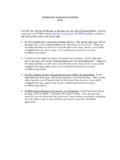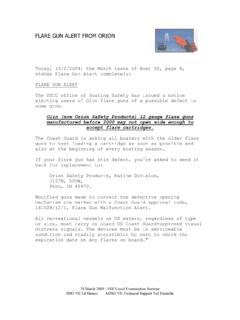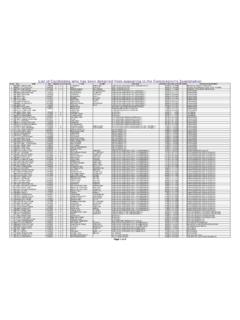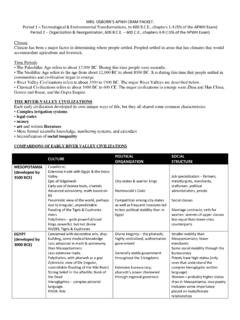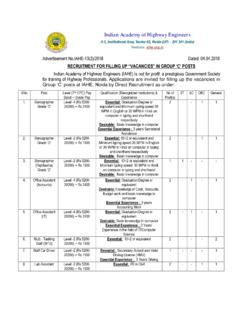Transcription of Auxiliary Qualifications”
1 Auxiliary Qualifications The How To Guide for getting ahead in the Auxiliary This guide will provide information on completing the following qualifications: Air Crew Air Observer Auxiliary Operations- specialty courses Auxiliary Procedures Course Boat Crew Coxswain Good Mate Incident Command System Instructor Initial Indoctrination to Marine Safety Introduction to Marine Safety RBS/Program Visitor (PV) Vessel Examiner (VE) January, 2011 Auxiliary Qualifications Table of Contents Introduction .. 2 Purpose of Guide .. 2 Description of Guide Mechanics .. 3 Types of Membership Status .. 3 Training Activities .. 4 Course Examinations .. 5 Documentation Current Revision.
2 5 Administrative Procedures Course (APC) .. 6 Incident Command System (ICS) .. 7 Instructor (IT) .. 8 Vessel Examiner (VE) .. 9 RBS/Program Visitor (PV) .. 10 Marine Safety .. 10 Auxiliary Operations Program .. 11 Boat Crew .. 13 Coxswain qualification .. 13 Air Operations (AUXAIR) .. 14 Training for Air Observers .. 15 Uniforms .. 17 Guide to Obtaining Auxiliary Forms and Manuals on the Internet .. 18 Page 1 Auxiliary Qualifications Introduction The United States Coast Guard Auxiliary is the civilian component of the Coast Guard. The Auxiliary was authorized in 1939 by an act of Congress as the Coast Guard Reserves. Congress later amended the act with passage of the Auxiliary and Reserve Act of 1941, which designated the Reserve as a military branch of the active service, while the civilian volunteers became the Auxiliary .
3 In addition to assisting the Coast Guard in Search and Rescue missions (air and sea) and in training exercises, we perform courtesy vessel checks, teach boating-safety classes, maintain relationships with local marine stores and marinas, and routinely patrol local waterways looking for navigational hazards and pollution problems. The Four Cornerstones of the Auxiliary : Member Services Recreational Boating Safety Operations and Marine Safety Fellowship _____ Purpose of Guide The purpose of this guide is to provide new members, as well as Flotilla Commanders (FCs) and Member Training officers (FSO-MTs), with an easy-to-follow flexible resource, that will help integrate new (or reactivating) members into the Auxiliary .
4 This "guide" can be used to assist MT officers, at all levels, with a source of information, directed toward increasing Auxiliarists' knowledge, and skill base. The requirements for obtaining qualification in each of the programs are as set forth in the Auxiliary Manual COMDTINST In some cases, additional guidance consistent with the local needs of the respective district must be considered. Page 2 Auxiliary Qualifications Description of Guide Mechanics This guide is intended to provide a step-by-step process to become qualified in the basic program competencies that have proved to be of greatest interest to new members. Most of the qualification requirements listed can be accomplished either through self-study or by attending qualification courses.
5 While some of these self-study qualifications will be relatively easy to accomplish alone, there is much to be gained by attending courses offered by a flotilla or division in order to develop friendships and to take advantage of the experience of other Auxiliarists. Organized courses also provide the opportunity to learn about unique requirements for the area in which you will operate. When you have mastered the course material you will be required to prove your understanding or specific skill set by either passing a test or demonstrating specific tasks. Whether a new member decides to use on-line training or organized training it is important to work with an experienced mentor able to guide you through your training and who will be available to assist when necessary.
6 Contact your Flotilla Commander (FC) or your Flotilla Member Training Officer (FSO-MT) to request a mentor for each of the topics you plan to study. Your mentor will help you obtain the necessary course material, answer questions and take the required tests. Each section of this document identifies the requirements or tasks to be performed and the reference material to conduct the action. Each of the course specialties requires specific reference documents, many of which can be downloaded from specified web addresses or they can be ordered for you for free by the Flotilla's Materials Officer (FSO-MA). The tables that follow each course description list the applicable steps and reference documents you will need to complete your training and become a valuable, recognized member of America's premier boating safety organization and a proud member of the Coast Guard family.
7 Welcome aboard! _____ Types of Membership Status The US Coast Guard Auxiliary recognizes four membership levels. These can be briefly described as follows: Approval Pending (AP) An applicant has completed and submitted all of the application paperwork defined in Chapter 3 of the Auxiliary Manual COMDTINST and is awaiting a Favorable Personnel Security Investigation (PSI) determination. Initially Qualified (IQ): Once a member has attained a favorable PSI determination, DIRAUX will change the member's status in AUXDATA from AP to IQ. A member will be listed as IQ only if he/she has satisfied all the requirements stated above, has received a favorable PSI but has not taken or passed a recognized Boating Safety Course (see the Auxiliary Manual COMDTINST Chapter 8, Section & b).
8 Basically Qualified (BQ): Members who have taken one of the recognized Boating Safety Courses and have received a favorable PSI will be listed as BQ. - This level of categorization is necessary to participate in Operations programs. AUXOP: A member may also obtain the prestigious level of AUXOP by completing the requirements outlined in the Auxiliary Manual COMDTINST Page 3 Auxiliary Qualifications Training Activities The policy for Auxiliarists in Approval Pending (AP) status allows active participation in many Auxiliary activities. This is especially true in the area of training. The details are available at Auxiliarists at all member levels are authorized to take any and all Auxiliary courses.
9 Each Flotilla should provide its members with access to essential course materials in order to facilitate each member's desire to learn. Members should first seek training through their flotilla. All Auxiliarists are authorized to take any and all end-of-course exams associated with their training. Certifications and successful completion of all courses will not be recognized until the test results are entered in AUXDATA by DIRAUX and a recognition letter is received. While Auxiliarists in AP status train alongside Auxiliarists in IQ, BQ, or AUXOP status, they may not displace IQ, BQ, or AUXOP status Auxiliarists who desire to participate in any training venue. AP and IQ level Auxiliarists should remember that successful completion of any approved boating safety courses prescribed in the Auxiliary Manual remains a prerequisite for qualification in all of the training programs described in this manual.
10 An AP candidate for boat crew may be certified if a safe boating class has been successfully completed. Finally, any Auxiliarist (regardless of status) beginning a new training program is considered a trainee and is not authorized to operate as qualified until a letter of certification is delivered to the member. Thus, no trainee shall operate as a Vessel Examiner, Boat Crew, Program Visitor, etc. until certification is official. Continued training, accompanied by a qualified member, may occur and is encouraged while awaiting certification. One final admonition is necessary. Keep copies of all forms and paperwork you submit, including test results, letters, and certificates.
